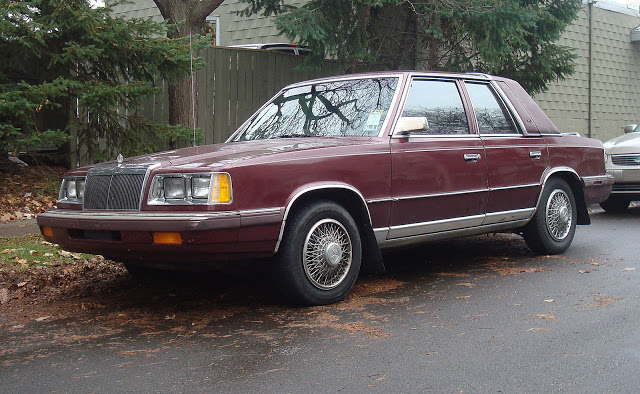

| Online: | |
| Visits: | |
| Stories: |

| Story Views | |
| Now: | |
| Last Hour: | |
| Last 24 Hours: | |
| Total: | |
Making New Memories in the LeBaron
Thursday, February 25, 2016 6:09
% of readers think this story is Fact. Add your two cents.
Fictionally, let’s presume an elderly great uncle has just passed, and YOU are set to inherit his 1987 Chyrsler LeBaron sedan. He was a dentist, and the car was garaged and only driven in fair weather. The oil was changed every 2,800 miles, and the maroon paint has a deep shine. It’s hard to say exactly what to do with the car. Even though it has only 46,000 miles, it’s not valuable on the open market, nor is it collectible or fashionable. Nonetheless, it works perfectly, gets 28 mpg, and still smells of vanilla “little tree” air fresheners. It was his pride and joy.
Forgetting for a moment that this machine goes 75 miles per hour, using carefully timed explosions of gasoline — forgetting that it works exactly as it was intended to do — it’s just not fashionable. But it’s yours!
When it comes to the aesthetics of liturgy, many of us young Catholics find ourselves in a similar position. We’ve inherited the architectural experiments of the 1950s, 60s, and 70s, all of which were built to outlast the Cold War. Terrazzo floors, thick brick walls, conduit wiring, metal roofs, steam heat… these things were meant to last. With the return to more ancient, and arguably more beautiful, styles of architecture, these 1960s structures are just not fashionable anymore.
The best way to honor a gift and its giver, however, is to use it, and use it well. I would like to suggest that the best way to inherit these structures is (1) to appreciate and participate in the communities that call them home, and (2) gently to encourage liturgical excellence and obedience, and lastly (3) to seek to foster a “hermeneutic of continuity” as much as possible.
After four years serving as Director of Music in an 1870 stone neo-Gothic church, with two historic pipe organs and German stained glass, I recently accepted a full-time position closer to home in a parish which meets in a modern building. Over 1600 families call this parish home, the church is filled to capacity with young families for four Masses each weekend, and over 700 kids are in religious education. The parish is growing, and the liturgy is meeting the spiritual needs of the community. The congregation sings well and participates devoutly. There are several choirs and a string orchestra. The pastor very much appreciates good music, and would like to see the music program develop. It’s a wonderful place, and I’m thrilled to be a part of it. I look forward to doing great work in this vibrant parish.
If our focus were entirely on the aesthetics of the church building, we could see poverty. If however, we are looking for grace and faith, we see explosions happening everywhere, and a community cruising at 75 mph in the fast lane. As it turns out, people in this parish are seeking to grow in their Catholic faith, too. These good folks ought to be encouraged and loved; and pastorally speaking, it is my sacred duty as Director of Music to lead them gently to the greenest pastures our Catholic tradition has to offer.
This past Sunday evening, over 35 people gathered to sing Compline, using traditional Gregorian Chant. It was the first time singing the office for many of them, and each week more people show up. Similarly we have returned to singing the psalm at Mass using the text as written in the Lectionary and psalm tones. This seemingly small point of obedience was a big step for some, but it turns out people are grateful and appreciative. It helps that we’re taking special care to sing the lectionary psalms well. These are little steps in a good direction. Good taste, gentle leadership, and excellence go a long way.
Naturally, you can see the point of my article. I would like to encourage tradition-loving Catholics not to turn their noses up at the LeBaron. Parish work in all settings takes patience, respect, a listening ear and open mind, leadership and obedience to the mind of the church, a strong and meaningful personal faith, courage, and lastly some social skills and gentleness. In years past, I viewed the liturgical and musical failings of local parishes as moral faults, plain and simple. After all, the rules are all in the GIRM, aren’t they? For me, for years, the result of this approach was anger, frustration, despair, and eventually isolation. Not only did it become a scandal for me, I was also making absolutely no progress toward a solution. This is a very dangerous road, and really it’s a dead end.
We, however, are educators and mentors first. We hold the standards in one hand, and the student in the other. It is never acceptable to mock a student for things outside of his control. Instead, every day, an educator breaks big goals into smaller tasks. In fact, it’s so engrained in the teaching profession that we have an acronym for it: TSWBAT or “Today Students Will Be Able To.” What improvements can we make today? Liturgically speaking, we have to work gently, consistently, and with the larger goal in mind. This larger goal is theological virtue: faith, hope, and love. Of course, these virtues are best understood in the context of obedience and humility; however, if we can achieve gradual overall improvement, we have accomplished much.
Source: http://www.newliturgicalmovement.org/2016/02/making-new-memories-in-lebaron.html



